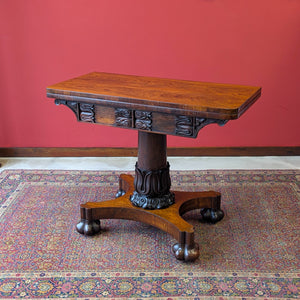Antique Occasional Tables Buying Guide
At Founders Antiques, we offer a carefully curated ever-changing collection of authentic antique occasional tables, including fine Georgian and Regency examples as well as later Victorian and Edwardian pieces. We look for pieces with strong form, good proportions and real decorative value, tables that work and sit well in a considered interior.
Whether you're seeking a tripod wine table or compact tilt-top table for the sitting room, a handy perch for letters in the hall or simply a small antique table that adds charm and usefulness without overpowering a space, you'll find a wide range of considered pieces that elevate everyday living.
Every occasional table we sell is ready to place in the home. A beautiful, functional addition designed to serve when needed and stand gracefully when not.
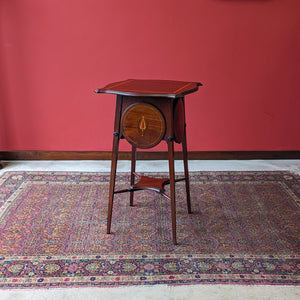
How Antique Occasional Tables Differ from Other Small Tables
Labels of course don’t really matter, but they can most certainly help us define and group related antique table types, making it easier for people to find the kind of piece that suits their intended purpose. So, what is an occasional table? And What’s the difference between occasional and side tables? What distinguishes them from other types of small antique tables?
Antique occasional tables are often misunderstood as a broad category, but in reality they represent a distinct and clearly defined form within English period furniture. Small in scale, they were not made to live permanently in one fixed position. Instead, they were designed to be brought into use when needed. To serve tea, hold a glass, support a book, and then moved aside. This temporary function is what sets them apart from other small tables. Yet when moved aside, they take on their secondary function; to sit quietly in a room and offer lasting visual pleasure through form, material and proportion.
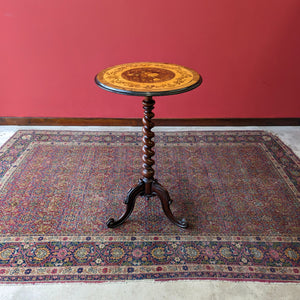
Occasional tables are typically freestanding, light in construction, and often but not always, circular or oval, designed for stability and beauty with a minimal footprint.
These traits firmly distinguish them from side tables, which are generally intended as permanent fixtures placed beside another piece of furniture or positioned against a wall. They are also distinct from tea tables or games tables, which were purpose-built for specific domestic activities, and from sewing or work tables, which often include drawers, compartments or rising tops for function-specific use.
True antique occasional tables strike a balance between decorative elegance and subtle practicality. They are not background furniture. They were designed to be used, admired and moved. It’s this flexibility of form and purpose that defines them.
In short, antique occasional tables are defined by their temporary use, graceful proportions, and visual presence, not by their placement or function alone.
Understanding Wood Selection in Antique Occasional Tables
Most antique occasional tables were made in well-figured hardwoods that balanced elegance with strength. The wood used can often tell you a great deal about a piece’s quality, age and intended setting. Occasional tables were not generally utilitarian pieces, although highly practical. They were made to be seen, and cabinetmakers therefore often selected particularly attractive timbers that combined refinement with durability.
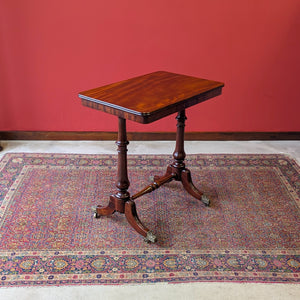
The most common wood used in the crafting of a period occasional table was mahogany, prized for its fine grain, rich colouring and ability to facilitate delicate turning and carving. Mahogany occasional tables, particularly those from the Georgian, Regency and Victorian periods, will often display warm, deep tones and a mellow patina developed over centuries of use.
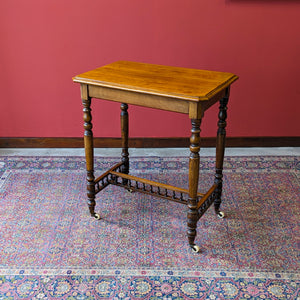
Walnut became more prominent in later 19th-century tables and into the Edwardian period, offering a lighter visual touch and more expressive grain. These pieces often feature thinner veneers laid over a solid base, with bookmatched tops or decorative burrs adding richness without heaviness. A good walnut occasional table can feel more sculptural and expressive than earlier forms.
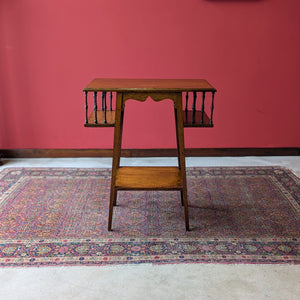
Oak is often associated with more provincial or utilitarian leaning pieces, where practicality and local materials often took precedence. Such oak tables tend to be simpler in form and construction, offering a more rustic character and a slightly heavier appearance. However this certainly isn’t always the case, particularly within the category of occasional tables where some oak examples often show more detailed workmanship and provide a distinctly decorative aesthetic.
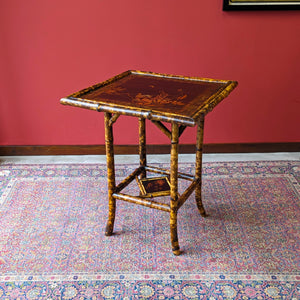
By the time of the Aesthetic Movement, bamboo became a stylish choice for occasional tables, perfectly aligned with the ideas of lightness and decorative appeal so important in this category.
Whatever the material, timber quality is a key indicator of a piece’s original intent and value. We love occasional tables with honest surfaces, rich natural colour and well-judged proportions. Whether in mahogany, walnut or oak, a good occasional table should show signs of use, age and purpose, bringing life into a living space as they go on combining practicality and visual interest as they have done for generations.
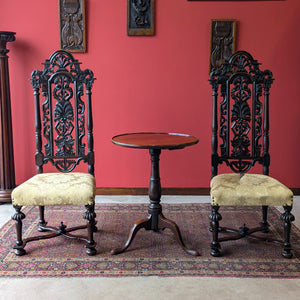
Common Styles and Forms of Antique Occasional Tables
Among the most recognisable forms of antique occasional table is the tripod table, with its three-legged base and central turned column, typically supporting a dished or circular top and often incorporating a tilt-top mechanism for ease of storage and added decorative appeal when not in use. These were often made in mahogany or walnut and served a variety of informal purposes.
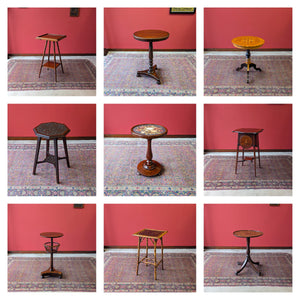
Closely related are wine tables, which are generally lighter and smaller, often with similarly rounded tops and slender proportions, designed to hold decanters or glasses.
Also prevalent are the more decorative four-legged occasional tables, a category that includes a broad range of small, freestanding designs with square, hexagonal or rectangular tops, often inlaid or lacquered and supported by finely turned or splayed legs.
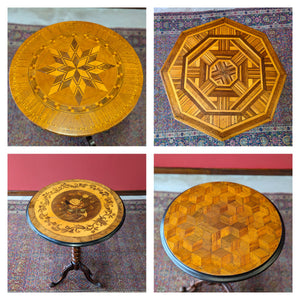
The tops of antique occasional tables were often treated as canvases for decorative craftsmanship, with intricate inlay, veneering, japanned finishes and parquetry, all used to elevate even the smallest pieces. Cabinetmakers took great pride in these surfaces, employing techniques such as marquetry, crossbanding and geometric parquetry to create striking visual effects in contrasting timbers. These embellishments weren’t merely decorative, they signalled quality and refinement, transforming functional tables into focal points within a room.
Antique Occasional Table FAQ's
What is an antique occasional table?
An occasional table is a small, freestanding, often decorative table designed for temporary or flexible use. Rather than being fixed in one location, they are typically lightweight and moved into position as needed.
How is an occasional table different from a side table?
Side tables are usually fixed beside other furniture or against a wall. Occasional tables are lighter, more mobile, and not tied to a specific position.
Where should I use an occasional table?
They work well in sitting rooms, halls, studies or landings; anywhere a light, useful, flexible surface is needed.
What should I look for when buying an antique occasional table?
Good proportions, beautiful grain figuring and honest attractive wear. Look for something you’ll enjoy pulling up beside you as you settle down for a glass of wine with a good book.
Can occasional tables be used as bedside tables?
Yes, if the proportions work. They're ideal if you want something less expected and lighter than a typical bedside.
Can I mix an occasional table with modern furniture?
Yes, their scale, aesthetic and practicality often make them perfect accent pieces in contemporary rooms.
Can I use an occasional table between two armchairs?
Of course, just check the height. Many are perfect for placing a drink or book between chairs. You may choose to have it as a more permanent fixture with a lamp on, but if ever needed it could very handily be pulled into position for another temporary use.
Can an occasional table be used under a window?
Definitely, occasional tables often fit beautifully below a sill and create a lovely display space, ready to be moved into position for further use.
Each occasional table in our collection is hand-picked for quality, originality and character, and every one is ready to place in the home.
If something catches your eye, you can buy directly online with UK delivery included. Prefer to speak first? We're always happy to help… get in touch to ask a question or request more information on any table.







































